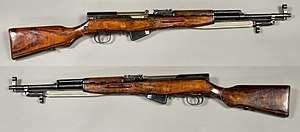Semi-automatic rifle

A semi-automatic rifle is a type of self-loading rifle ("SLR", also called auto-loading rifle) whose action will automatically cycles (ejects and rechambers) a new round after each shot, but needs the shooter to manually reset the hammer/striker (by relaxing the trigger-pull) before the next shot can be fired, so only a single round will be discharged each time the trigger is depressed.
In contrast, a fully automatic rifle both cycles the cartridges automatically and cycles (resets and releases) the hammer/striker automatically (as opposed to semi-auto guns, which do only the former) when the trigger is pulled, so for the duration of the trigger-pull the full-auto gun will fire multiple rounds continuously until the ammunition are depleted.
Operation
Semi-automatic weapons use gas, blowforward, blowback, or recoil energy to eject the spent cartridge after the round has traveled down the barrel, chambers a new cartridge from its magazine, and resets the action; enabling another round to be fired once the trigger is depressed again.
The self-loading design was a successor to earlier rifles that required manual-cycling of the weapon after each shot, such as the bolt-action rifle or repeating rifles, which required the operator to manual cycle the action before each shot. The ability to automatically load the next round allowed for an increase in the rounds per minute the operator could fire. Semi-automatic rifles are versatile designs. They can be efficiently fed by en-bloc clip and internal magazine, detachable magazine or a combination of stripper clip and internal magazine.
History
The first successful design for a semi-automatic rifle is attributed to Austrian gunsmith Ferdinand Ritter von Mannlicher, who unveiled the design in 1885.[1] The Model 85 was followed by the equally innovative Mannlicher Models 91, 93 and 95 semi-automatic rifles.[2]
Blowback semi-automatic
In 1903 and 1905, the Winchester Repeating Arms Company introduced the first semi-automatic rimfire and centerfire rifles designed especially for the civilian market. The Winchester Model 1903 and Winchester Model 1905 operated on the principle of blowback in order to function semi-automatically. Designed entirely by T.C. Johnson, the Model 1903 achieved commercial success and continued to be manufactured until 1932 when the Winchester Model 63 replaced it.
By the early 20th century, several manufacturers had introduced semi-automatic .22 rifles, including Winchester, Remington, Fabrique Nationale and Savage Arms, all using the direct blow-back system of operation. Winchester introduced a medium caliber semi-automatic rifle, the Model 1907 as an upgrade to the Model 1905, utilizing a blowback system of operation, in calibers such as .351 Winchester. Both the Models of 1905 and 1907 saw limited military and police use.
Early semi-automatic rifles

In 1906, Remington Arms introduced the "Remington Auto-loading Repeating Rifle." Remington advertised this rifle, renamed the "Model 8" in 1911, as a sporting rifle. This is a locked-breech, long recoil action designed by John Browning. The rifle was offered in .25, .30, .32, and .35 caliber models, and gained popularity among civilians as well as some law enforcement officials who appreciated the combination of a semi-automatic action and relatively powerful rifle cartridges. The Model 81 superseded the Model 8 in 1936 and was offered in .300 Savage as well as the original Remington calibers.
Mexico with the Mondragón rifle (7x57 Mauser) was the first nation to use a semi auto rifle in battle, issued to regular troops (Mexican revolution 1910). Later France used a semi-automatic rifle the Fusil Automatique Modele 1917. This is a locked breech, gas-operated action which is very similar in its mechanical principles to the future M1 Garand in the United States. The M1917 was fielded during the latter stages of WWI but it did not receive a favorable reception. However its shortened and improved version, the Model 1918, gave complete satisfaction during the Moroccan Rif War from 1920 to 1926. The Lebel bolt-action rifle remained the standard French infantry rifle until replaced in 1936 by the (also bolt action) MAS-36 despite the various semi-automatic rifles designed between 1918 and 1935.
Other nations experimented with self-loading rifles between the two World Wars, including the United Kingdom, which had intended to replace the bolt-action Lee–Enfield with a self-loading rifle, but discarded that plan as the imminence of the Second World War and the emphasis shifted to speeding-up re-armament with existing weapons. The Soviet Union and Nazi Germany both issued successful self-loading and selective-fire rifles on a large scale during the course of the war, but not in sufficient numbers to replace their standard bolt-action rifles.
Gas-operated rifles

In 1937, the American M1 Garand was the first semi-automatic rifle to replace its nation's bolt-action rifle as the standard-issue infantry weapon. The gas-operated M1 Garand was developed by Canadian-born John Garand for the U.S. government at the Springfield Armory in Springfield, Massachusetts. After years of research and testing, the first production model of the M1 Garand was unveiled in 1937. During World War II, the M1 Garand gave American infantrymen an advantage over their opponents, most of whom were issued slower firing bolt-action rifles.[3]
The Soviet AVS-36, SVT-38 and SVT-40, as well as the German Gewehr 43, were semi-automatic gas-operated rifles issued during World War II in relatively small numbers. In practice, they did not replace the bolt-action rifle as a standard infantry weapon of their respective nations.
Another gas-operated semi-automatic rifle developed toward the end of World War II was the SKS. Designed by Sergei Gavrilovich Simonov in 1945, it came equipped with a bayonet and could be loaded with ten rounds, using a stripper clip. However, the SKS was quickly replaced by the AK-47. It was the first widely issued rifle to use the 7.62×39mm cartridge.[4]
Select examples
- Mondragón rifle
- Mauser M1916
- M1917 RSC
- M1922 Bang rifle
- General Liu rifle
- M1 Garand
- SKS
- Dragunov Rifle
- Gewehr 43
- SVT-40
- Charlton Automatic Rifle
- Ag m/42
- Rasheed Carbine
- AR-10
- AR-15
- L1A1 Rifle
- Heckler & Koch PSG1
- Heckler & Koch SL8
- Heckler & Koch SL7
- Heckler & Koch SL6
- Farquhar-Hill Rifle
- Kbsp wz. 1938M
- M1 Carbine
- Springfield Armory M1A
- Ruger Mini-14
- M1941 Johnson rifle
- Gewehr 41
- vz. 52 rifle
- MAS-49 rifle
- FN Model 1949
- Ruger 10/22
- Marlin Model 60
- Remington Model 7400
- Remington Model 8
- Winchester Model 1907
- Walther WA2000
- ZH-29
See also
- Assault rifle (not to be confused with "Assault weapon")
- Assault weapon - certain semi-automatic rifles are classified as assault weapons in some jurisdictions
- Firearm
- AR-15 style rifle
- Personal defense weapon
- Rifle
- Semi-automatic firearm
- Shotgun
- Single-shot
- List of semi-automatic rifles
References
- ↑ Jewison, Glenn; Steiner, Jörg C. (2010). "Ferdinand Ritter von Mannlicher". austro-hungarian-army.co.uk. Glenn Jewison.
- ↑ Smith, Walter H.B. (1947). Mannlicher Rifles and Pistols: Famous Sporting and Military Weapons. Military Service Publishing.
- ↑ "Firsts: Springfield 375". 2011. Archived from the original on March 14, 2012.
- ↑ Hogg, Ian (2002). Jane's Guns Recognition Guide. Jane's Information Group. ISBN 0-00-712760-X.
